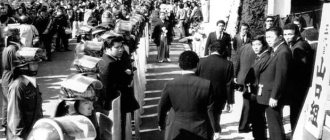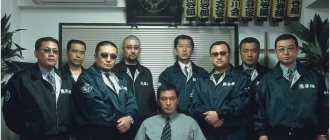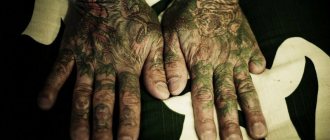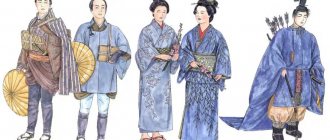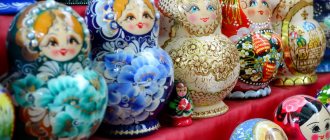The Japanese Yakuza is the main criminal group in Japan. Among the Japanese police and the media, they are usually called boryokudan, which can literally be translated as “gang.” However, representatives of the crime syndicates themselves consider this word offensive, since it can be applied to any type of crime. In Asian countries there are many groups similar to the Yakuza, for example, the Chinese equivalent of the Japanese Yakuza is a triad.
The Japanese Yakuza mafia, without a doubt, is a social group that is known not only in its own country, but also abroad. Members of the group have influence in the most significant spheres of life in Japanese society, especially in politics and business. Even though they are members of the underworld in Japan, the yakuza are treated with a certain respect due to the fact that they preserve and strictly follow their centuries-old traditions.
The history of the appearance of the Yakuza
It is generally accepted that the origins of the Yakuza in Japan trace back to the two largest crime syndicates during the Edo period:
- Tekiya was a gang consisting mainly of bandits and ronin who had lost their ruler. This group was usually involved in robberies and resale of stolen items.
- Bakuto - members of this group were vassals who lost all their property and lands under the influence of the shogun. Their main income was organizing and conducting gambling.
The modern yakuza's connection to the criminal gangs of the Edo period can be seen in their rituals, which have many similarities with the rituals of tekiya and bakuto.
During World War II, the Japanese yakuza clans lost their importance and were destroyed, as all the attention of the Japanese was aimed at suppressing hostilities. Most of the people who were in gangs were killed. After the end of the war, the remaining representatives of the Yakuza began to revive their group again.
Maoists against triads
During World War II, when the Japanese occupied most of China, members of the triads supported the guerrillas and fighters against the invaders. They used the still existing opium smuggling channels both to supply weapons and to rescue residents from occupied territories. Triad fighters organized resistance to enemies in cities, attacked warehouses and rear units. True, this selfless heroic assistance lasted only until the end of the war. When China was liberated and Japan was defeated, the criminal gangs returned to their old ways.
After the end of the war, the leaders of the triads decided that the time had come to take power in China into their own hands. They did not have time to implement these plans. In 1949, the Communists came to power and immediately launched a powerful offensive against crime. Membership in secret societies in China still carries the death penalty. Fearing for their lives, most of the criminal tycoons moved to Hong Kong, which was under the control of the British.
In the 1950s, according to local police estimates, more than three hundred thousand gangsters lived in Hong Kong. The number of criminal organizations numbered in the dozens. Most of them hid behind completely legal forms of business - from laundries to restaurants. The authorities have long underestimated this threat. The active fight against crime began after 1956, when triads, taking advantage of political unrest, carried out several large robberies. New laws have been passed against money laundering schemes. This made it possible to reduce the crime rate for some time.
Yakuza rituals
Yubitsume is a ritual of cutting off fingers. According to this tradition, if a gang member commits any offense, as punishment he must cut off part of the little finger on his left hand and present it to his boss.
The roots of this tradition come down to the peculiarities of fencing with a Japanese sword. To keep the sword securely in the hand, it is clasped with three fingers of each hand, but the index and thumb are not in such tension as the rest. Cutting off the tips of the fingers, starting with the little finger, makes the grip weaker, as a result of which a person cannot inflict fatal blows on the enemy and he can only defend himself.
Looking through photos of the yakuza on the Internet, you will notice that they have a lot of irezumi tattoos all over their bodies. The difference between this tradition and the usual tattoo procedure is that almost all yakuza tattoos are done by hand, that is, using bamboo or ordinary needles, paint is injected under the skin. This procedure is considered very painful and expensive, and the process of applying a tattoo with a needle can take more than one year. Usually, members of the group carefully hide their tattoos, but during a game of cards - oycho-kabu, they take off their shirts and tie them on their belts, thereby showing each other the patterns on their bodies.
One of the most famous Yakuza traditions is drinking sake together - such a ceremony helps strengthen relationships not only within the clan, but also enlists the support of other mafia groups.
Hierarchy of the Yakuza
The basis for the modern hierarchy in the Japanese mafia clan is the “father to son” system. The head of the gang is called oyabun or kumite, which translates as "head of the family", and his subordinates are kobun. To prove their loyalty to the head of the clan, the kobun renounce their blood ties and take an oath of allegiance to the clan leader. In addition to the oath, the sakazuki ritual is performed - the recruit and the head of the clan drink sake from the same bowl, after which they are considered members of the same family. Also in the clan there are saiko kamon “senior adviser” and so-honbucho, who are assistants to the head of the clan. After them in the hierarchy comes wakagashira - the manager of a small number of gangs in a particular area, and sateigashira - the person assigned to control specific gangs. A gang usually consists of 20 to 200 people, and a clan can consist of up to several tens of thousands of yakuza.
The bulk of the group's representatives are men; women members of the criminal group are very rare, and they are addressed differently from men; they are called nee-san, which translated sounds like “elder sister.”
Despite the fact that it is very rare to meet a woman among gang members, there are cases where the wife of a deceased kumite could become the new boss. Such an incident occurred in the Yamaguchi-gumi crime syndicate, where Fumiko, the wife of the late Kazuo Taoka, led the clan in her husband's place.
The Yakuza leader was released. He will no longer be able to return to his former greatness.
Takayama case
The Yakuza is a type of Japanese mafia that consists of various clans. The largest and most powerful group is the Yamaguchi-Gumi. Its leader is Kenichi Shinoda. The released Kiyoshi Takayama is his deputy and the second most important person in the crime syndicate.
Interpol found the head of the yakuza using a viral photo after 15 years
More details
One of the country's most important gangsters was caught extorting. He demanded 40 million yen (more than 23 million rubles at the current exchange rate) from the businessman. For this money, Takayama offered him “protection” from attacks by other criminals.
A criminal case was opened against the attacker and sent to court. During the hearing, prosecutors demanded 10 years in prison for the arrested man, but lawyers managed to insist on a shorter term. In March 2013, the court sentenced him to six years in prison.
The accused himself did not admit his guilt and denied any involvement in racketeering.
Overall, Takayama's extortion is not particularly surprising. Yakuza often offer security to organizations for a fee. In Japan this is called “mikajimere” and is one of the main ways of earning money for members of the group.
Release to freedom
Six years later, Kiyoshi Takayama was able to rejoin Yamaguchi-Gumi, which had undergone many changes during his absence.
The Japanese man was released from prison located near Tokyo on October 18, 2021. His headquarters is in Nagoya, so after his release he headed there. The local police managed to prepare for the meeting.
At the station, one of the powerful mafiosi was met not only by his associates, but also by a couple of dozen law enforcement officers. Now in Japan, not everything is quiet among criminal gangs, so law enforcement officers were afraid of possible clashes.
Takayama is now 77 years old, but he is unlikely to leave his life’s work in the mafia. According to the police, his appearance could trigger a wave of new clashes between different groups. The war of Japanese criminals has lasted since 2015 and during this time nine people have died.
Kodokai and Yamaguchi-gumi
The underworld of Japan is divided among three main gangs - Sumyyoshi-kai, Inagawa-kai and Yamaguchi-gumi. The last group remains the most bloodthirsty, numerous and rich.
Members of the Yamaguchi clan do business around the world, earning billions of dollars. The scope of their activities includes the sale of weapons, drugs, real estate fraud, the organization of prostitution and much more.
The Yakuza also has its own differences from other global criminal organizations. The group does not hide the names of its leaders, the addresses of its headquarters, or its numbers. Many associations even have official logos or websites.
The emblem of the Yamaguchi-Gumi group. Photo source: wikipedia.org
Yamaguchi-gumi, for example, created their own magazine in 2013 with a code of honor, haiku poems and even fishing tips. It was distributed only among gangsters, but, according to some sources, copies fell into the hands of ordinary people.
Now in Japan there are more than 20 Yakuza criminal groups that are registered with the police. Yamaguchi-gumi was founded in 1915 by Harukichi Yamaguchi.
Kenichi Shinoda and Takayama organized Kodokai in 1984, which was a kind of branch of Yamaguchi. Later, in 2005, Shinoda became the leader of the main gang, and Takayama remained the president of Kodokai. In 2012, the gang was recognized as a “particularly dangerous criminal armed group.” No other mafia organization in the country had such a status.
Photo source: Flickr
Is the Yakuza no longer the authority?
Despite its fame and leading position in Japan, during the years of Takayama's imprisonment, the Yamaguchi-gumi split into three warring criminal groups. After the appearance at the helm of the Synod, “Kobe Yamaguchi-gumi” broke away, then “Ninke Yamaguchi-gumi” appeared.
The split was followed by numerous clashes, arrests and murders. At the same time, the number of the main mafia organization in Japan was greatly reduced. According to experts, Takayama's dictatorial style, which discriminated against some gangsters and patronized others, led to the collapse of the gang.
Japanese police have recorded dozens of mafia clashes between yakuza clans
More details
But other experts believe that the collapse of the Yamaguchi-gumi was the logical ending to the crisis that the group had experienced in recent years. Due to persecution, many mafiosi were sent to prison, while others died. There is almost no Synod about the Yakuza left.
It’s not just the Japanese authorities who have been fighting organized crime for many years. In the United States, organizations were prohibited from entering into transactions with Shinoda, and Takayama was blacklisted, freezing his American assets.
Such decisions by Washington led Tokyo to pass laws to sever the yakuza's connection with legitimate businesses.
In 2009, Yamaguchi-gumi tried to improve the situation. Gangsters introduced an exam for syndicate members to ensure their excellent knowledge of the laws. Japan has greatly tightened its legislation against organized crime, so the mafiosi have become more secretive.
Such measures did not help much and life is now very difficult for Yamaguchi. The yakuza cannot rent a car, go to a bar or temple, and are now experiencing financial difficulties. Firms are prohibited from collaborating with the mafia, and authorities have identified 277 crimes for which they can be sent to prison even at the stage of preparation for the offense.
